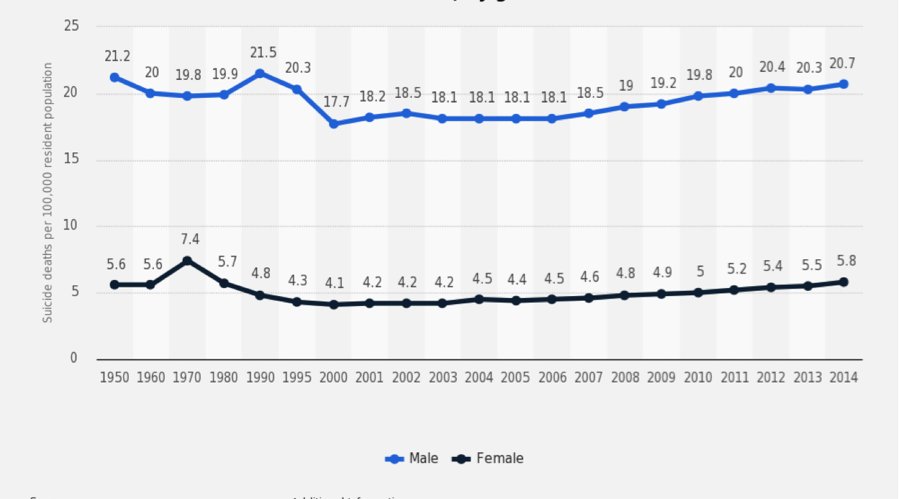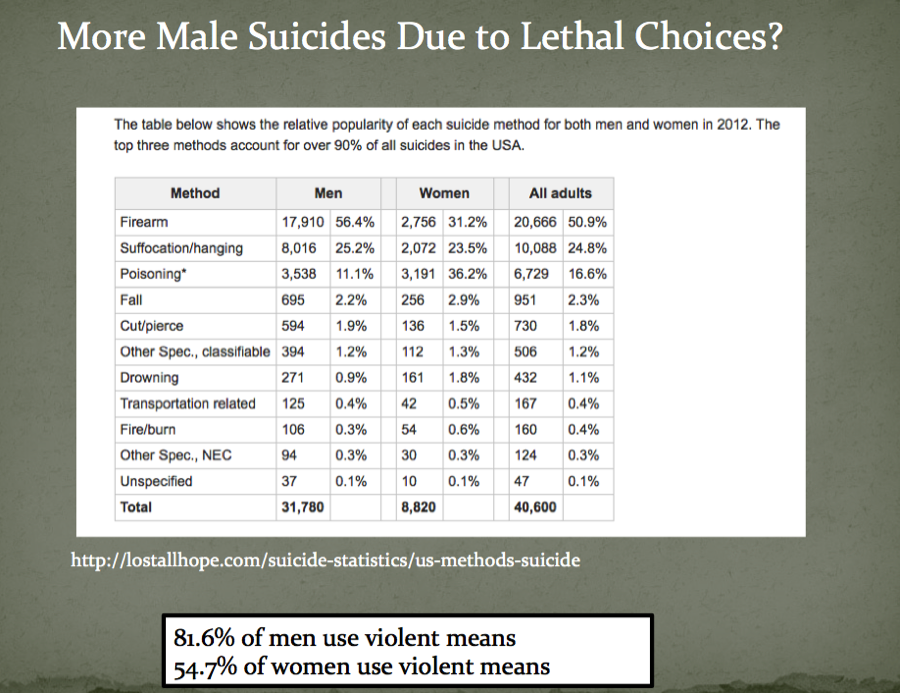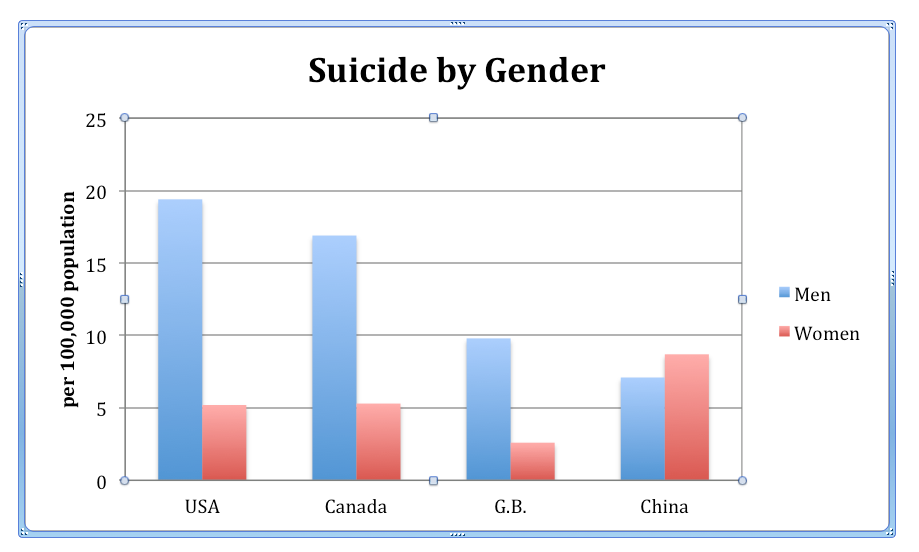Men commit suicide four times as often as women and no one knows why. This has been going on for many years. The chart below shows this ratio as being stable from 1950 to 2014 so that tells us that the ratio is not due to some recent shift in our cultural values or due to the economy or some other external source. (blue line is males, black line females, US suicides per 100,000) There are other stats that show that even in the 19th century this ratio seems to hold up. But why?
Let’s take a male friendly look into the possible reasons for this.
First we need to look at the standard manner of dismissing such a huge difference. So many people, including people in our educational systems, suicide prevention organizations and even researchers make the claim that men commit suicide more often due to their choice of lethal means. They point out that 25,926 males used lethal means to kill themselves in the United States in 2012 and only 2,818 females used the same lethal means. Most listen and then nod in agreement at how many men use lethal means and how few women, assuming this must be why men suicide more often than women. Then it is pointed out that many more males than females commit suicide so it is more accurate to compare the percentage of male and female suicides that use lethal means. Have a look at this chart and notice that men chose the lethal means of hanging or firearms in about 81.6% of their completed suicides. But also notice that women chose those same lethal means in 54.7% of their completed suicides. Those two numbers are not that far apart. Yes, this is probably a part of the reason for men to complete suicide more often than women but it in no way explains the mammoth four to one ratio that has held for years. Something else is obviously happening.
Most people are not even concerned about this difference. If you look at the suicide prevention web sites you will notice that this problem is rarely discussed on the first page and all too often not even on later pages. They usually fail to tell their readers that the largest risk factor for suicide is being male. This is such an important piece of data it is hard to believe that they routinely omit it but they do. Even government reports on suicide, college classes, media stories, suicide conferences and many others tend to fail in alerting people to this problem. People are simply not interested. Even researchers lack interest. Just try and find research studies that look into the reasons for this difference. You probably won’t find much.
There is one man, a psychologist, Thomas Joiner, who has theorized about this difference. Joiner points out a possible contributing factor for the 4 to 1 ratio is that men are more fearless and this fearlessness allows them the courage to end their own lives. A very interesting and at least partially true idea but again, it would be difficult to explain such a huge difference by one psychological trait. I think Joiner is on to something but I think it is just a part of the puzzle.
Let’s turn to some other ideas that might relate to our understanding why boys and men are so much more likely to complete suicide. Let’s first look at cultural messages.
CULTURE
It starts early. Little boys are told that BIG BOYS DON’T CRY. Most of us shudder at the thought that this clearly tells boys they need to stuff their feelings but there is an even more pernicious aspect to this. When an adult tells a little boy that big boys don’t cry they are indeed telling him to stuff his feelings but they are also telling him something else. They are telling him that when he does feel hurt and in need of support that they, the adult offering this idea, will not be there to help and offer compassion. So the message is two fold. First it tells the boys to stuff it and second it alerts him that when he is feeling hurt he should not expect support or compassion. He watches as his sisters get what he lacks. (for more information on boys see my book Helping Mothers be Closer to Their Sons: Understanding the World of Boys)
With this default it is simple to see that he will be unlikely to seek help when he has been taught for years that no support will be there when he is in need.
Much has been said about men being reluctant to express emotions but what has not been pointed out is that no one really wants to hear men’s emotions. How about you? When was the last time you offered to listen to a man who was emoting? Most of us have to answer that we haven’t done that for a very long time or possibly ever. A man’s emotional pain is generally seen as taboo, something that people want to avoid. You can contrast this with the way people see women’s emotional pain and you see that women’s pain is seen as a call to action. When women have tears people scurry to help, when men have tears people simply scurry away.
But that’s far from all our culture does to boys and men. As boys get older the culture refuses to accept any signs of dependency. Men, and sometimes older boys must appear to have things covered by themselves, to appear independent, and when they don’t, guess what happens? They are shamed as not being real men. A man named Peter Marin wrote an excellent article on homelessness and explained this very dynamic. Here’s what he said:
“To put it simply: men are neither supposed nor allowed to be dependent. They are expected to take care of others and themselves. And when they cannot or will not do it, then the assumption at the heart of the culture is that they are somehow less than men and therefore unworthy of help. An irony asserts itself: by being in need of help, men forfeit the right to it.“
Exactly. A man’s choice is to appear independent or face being judged as not being a real man. The hallmark of a suicidal person is to feel hopeless and helpless. So the man who feels hopeless and helpless also knows that if he exposes this he will be judged as not being a real man. This is a very tough double bind that men face. If I do open up about my helplessness and hopelessness I will be judged harshly, if I don’t open up I am totally on my own. Most men choose to be on their own. Can you blame them?
This is just one facet of what scientists have named “precarious manhood.” They have shown that around the world men and young men are expected to prove their manhood repeatedly in order to be considered men. Men are under constant surveillance to appear independent and if they fail to appear independent they pay a severe price in being devalued and judged as not being “real” men. Women face nothing similar. When girls reach physical maturity they are considered women, not so for the boys.
Men intuitively understand the above. They live it on a daily basis. However, women are not under similar pressures and don’t realize the hardships men face. Too many times women simply expect men to be more like them. I often see it in the couples therapy I do. The women expect their men to talk openly about their vulnerabilities, their feelings, and their need for help. This of course flies in the face of his certainty that his neediness and feelings will do nothing but harm to him and expose his dependence. He has a natural and learned tendency to do his best to appear independent and he comes by it honestly. For us to suddenly expect him to do a complete 180 degree change and appear needy is a bizarre and unreasonable expectation.
These two elements, not expecting any help to be available and routinely being shamed for any sign of dependence have a cumulative impact on men. When they do feel hopeless and helpless it is easy to see now why he would be less likely to open up about this to anyone.
RESEARCH
Let’s turn to the research and see if there are studies that help us understand why men would be so much more likely to complete suicide.
The work of Shelly Taylor is a good example of research that helps us in understanding this problem. Taylor realized in the early 2000’s that nearly all of the research on stress had been done only on male subjects. Women had been left out. What we know about fight and flight surely applies to men. Taylor proceeded to only study women under stress. She wondered if women might have different strategies. She found that women, unlike men, would be much more likely to “tend and befriend.” That is, women were more likely to move towards interaction when stressed, to move towards other people. A sharp contrast to the male tendency of fight and flight that moves men either into action or inaction. So think about it. Can you see how the female nature of moving towards others when stressed will make it much more likely that she will interact with a person who will realize her distress and then push her to seek services? Notice also that the male tendency to move to action or inaction under stress takes him away from concerned others. Indeed action and inaction are very powerful forms of healing (for more info see The Way Men Heal or Swallowed by a Snake: The Gift of the Masculine Side of Healing) but they do leave men more on their own to heal and a very powerful depression is a very difficult thing to heal by ourselves. The more feminine interactive modes are more likely to open avenues of loving others challenging our shame, guilt, and self deprecation. Healing with action and inaction will often lack this outer challenge from someone we love and this leaves men more at risk to persistent negative thoughts, shame, and guilt. His pain is less visible to others and this is dangerous in a powerful depression.
I hope you are seeing that men are taught to keep their emotions to themselves, that their emotional pain is not something that others want to hear, and that it is not something that does them much good if expressed. Rather, they see that if expressed they run into a wall of shame and judgment. It is a short step to now realize that for these reasons he is much less likely to seek “help.” First he knows it is likely not there for him but second he also knows that it’s a trap, if he does show his vulnerability he is toast.
BIOLOGY
Then there is the biological aspect to this. Men get 10 times more testosterone than women and we are now learning some fascinating things about testosterone. For years scientists have been unsuccessful in trying to connect testosterone with aggression. With improved research techniques they now know that rather than being related to aggression , testosterone pushes men to strive for status and to protect that status once gained. Men and to a lesser degree boys, are built to strive for status. Wanting to succeed, wanting to win, wanting to be good at something and working towards that are all now known to be related to testosterone. It’s easy to see how winning and succeeding are important to men and boys and also are the antithesis of dependency. When we win we are far from dependent. Boys and men are not only socially conditioned to be independent they are pushed in the same direction by their biology. Independence equals success, dependence equals failure.
Another impact of testosterone that has been verified recently is that it reduces fear and increases willingness to take risks. This adds some strength to Joiner’s ideas about fearlessness.
If you look at the factors we are discussing separately they don’t make much sense. Why push boys to not cry? Why try and win all the time? Why does precarious manhood push men to repeatedly prove their manhood? Why would testosterone push men to strive for status and take risks? Each by itself doesn’t make much sense. But if you look at them working together it begins to add up. All of these things are helping men in what is being called the masculine hierarchy. Big Horn Sheep butt heads to determine which male will have access to the top rated females, right? What scientists are now finding is that human males also live in a hierarchy. And, like the sheep, the bottom line of the hierarchy is reproductive access. Precarious manhood, testosterone, the desire to win and not be seen as dependent are all factors in moving upwards in the male hierarchy. None of this really makes much sense until you realize that women really, really, like high status. Men of high status, like millionaires, Senators, professional sports players, famous musicians all have a much better chance of attracting women than most guys on the street. These men are high in the male hierarchy. All men know this and will work hard to be as high in the hierarchy as he can, knowing that higher status means a better chance of success with very attractive women.
So really, the parents discouraging their sons from crying in public is done not as a crazy and inexplicable act but as a way to help him be higher in the hierarchy. They want their son to succeed. Same with precarious manhood. The pushing of males to repeatedly prove their worth is just another way to push him higher in the hierarchy. Testosterone does something similar when it pushes men and boys to strive for status. It is this striving for status that has literally built much of modernity. It is nothing to sneeze at.
Men live in this hierarchy each day, in fact, their lives are surrounded by hierarchy. What are men’s favorite sections of the newspaper? Sports and business right ? What do those have in common? Hierarchy after hierarchy. Things are broken down to who is first, second, third and on and on. IBM stock up today, DOW up but the NASDAQ down at the close of trading. RBI’s, batting averages, quarterback ratings and a host of sports stats are the domain and love of many men. Think hierarchy. Many men enjoy this and women are often perplexed.
? What do those have in common? Hierarchy after hierarchy. Things are broken down to who is first, second, third and on and on. IBM stock up today, DOW up but the NASDAQ down at the close of trading. RBI’s, batting averages, quarterback ratings and a host of sports stats are the domain and love of many men. Think hierarchy. Many men enjoy this and women are often perplexed.
The hierarchy is what it is, but it does have some lethal effects when it comes to suicide. Men will strive to stay up in the hierarchy as high as they can. But this means putting on your best face whenever possible, putting your best foot forward. In order to maintain your place in the hierarchy you don’t want to share your failures, your dependencies, or your depression. This puts men into a very dangerous place. Their lives have often been filled with striving for status and trying to put a successful face on for the public.
Women often do not understand this. They think that he should just get over it and start talking about stuff. But wait a minute. Women have a similar hierarchy. It’s called attractiveness. Women do their best to put their best foot forward when it comes to their appearance. While men’s hierarchical involvement is more global and touches nearly every sphere of his life, a woman’s hierarchy is more limited to attractiveness. Just as status is one of a man’s tickets to reproductive success, the same is true for women and attractiveness. And most women work hard at this. Just a quick look at the 64 billion dollar cosmetic industry should give you a sense of how important this is. Just for reference, the NFL, MLB and the NBA bring in a combined revenue of about 26 billion dollars. That’s less than half of the cosmetics. So women work hard to stay as near the top of their hierarchy as possible and they spend quite a bit to do so. Have you ever heard of a women refusing to leave the house without her makeup? Can you see how this is similar to the men? She wants to put her best foot forward and be able to mask her imperfections just like the men.
The difference is that women’s decisions to not go out without their makeup tends to have much less severe consequences than a man’s reticence over his depression. Depression is seen as failure, a status dropping weight that needs to be fixed privately and he is all too often left alone in the weight of his troubles.
Devaluing Men
There is one more factor that is rarely discussed that I think we need to at least mention. The devaluation of men and boys.
China is one of the only countries in the world where women commit suicide more than men. The chart below shows three western countries and then China. Notice that all of the western countries appear to have men outnumbering women. China however flips that and shows that female suicide in China actually outnumbers males. Why would this be? Why would almost every other country show men to outnumber women in suicides but China has more female suicides?
Most of the theorists point towards China’s devaluation of women as being the cause. They say that women in China are seen as inferior, boy babies are preferred to the point of aborting girl babies in order to have a male. Valuing males over females say the theorists, must create an environment where the females are more likely to take their own lives. I tend to think that their assessment is at least partly correct. But what does that tell us about our own country? I think a case can be made that in our country it is the men who are devalued, men are seen as inferior and this devaluation impacts men and boys in the US in the same way theorists are positing it impacts girls and women in China. Just look at how easy it is to bash men. Imagine yourself in public commenting that men are jerks. What response would that bring? I have seen this often and no one bats an eye. Most people will just nod. But now think what would happen if you proclaimed that women were jerks. I have seen this one too and can tell you what I have seen is people immediately defending women and castigating you for saying such a thing. This is a huge and unrecognized double standard. It’s not uncommon for people to laugh at men, for men to be forgotten when it comes to their emotional pain, for men to be devalued and used as cannon fodder, to die on the battlefield (97% male deaths), and in dangerous jobs (93% male deaths). Could it be that this devaluation of men and boys plays a role in their greater numbers of suicides? I am guessing yes.
CONCLUSION
I hope you are starting to get a sense of why men might commit suicide more often than women. Let’s list the factors we have discussed:
- Choice of more lethal means of suicide.
- Joiner’s ideas of fearlessness
- Big boys don’t cry and knowing there is no support
- Disallowing dependency in men
- Precarious Manhood (facing lifelong judgment about his manhood)
- Testosterone and its encouraging striving for status, limiting fear, and increasing tolerance of risk
- Hierarchical nature of men
- The devaluation of men and boys
Men, due to both biological and social factors are less likely to seek out “help” when they are depressed whether it’s a professional helping connection or a personal one. A great deal of the psychological community views this male tendency to avoid therapy and “help” as being pathological. I am hoping that from reading this article you will be able to see that it is more a natural consequence of the man’s nature, his hormones, and his environment. Our task is to find therapeutic interventions that will work with men. They will likely be starkly different from the traditional modes we now use. Our present therapeutic industry is built for women and their “tend and befriend” styles of healing and their face to face talking and emoting. This works great for most women and some men but it fails miserably for many men and some women. Therapy is not built for men and tends to miss the mark.
If we want to be of service to men we will need to change our ideas about healing and our modes of intervention.
Tom Golden is the author or three books, Swallowed by a Snake: The Gift of the Masculine Side of Healing, The Way Men Heal, and Helping Mothers be Closer to Their Sons: UnderStanding the Unique World of Boys. Tom was the creator of the youtube channel Men Are Good , was in the Red Pill Movie, and served as the vice chairman of the Maryland Commission for Men’s Health. He has been a therapist in private practice for over 30 years.





